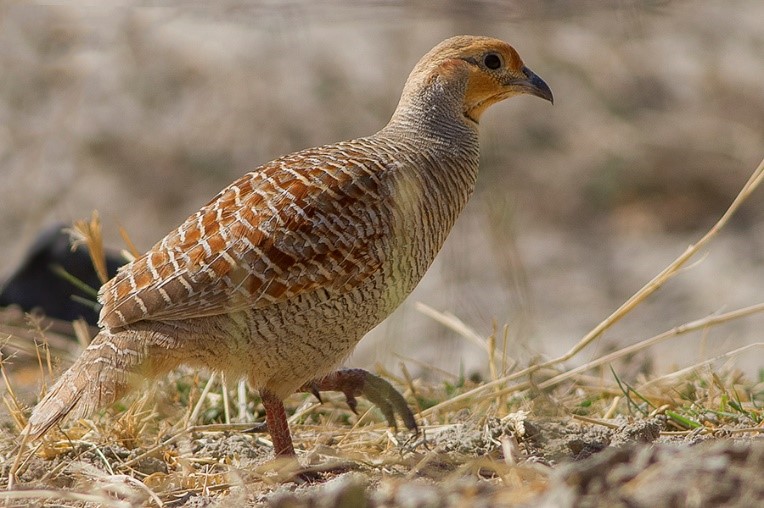Description

Disclaimer: Copyright infringement not intended.
Context
- Grey Francolin (Ortygornis pondicerianus), a ground-dwelling bird known for its distinctive calls and cryptic plumage, was reported inside the Sanjay Gandhi National Park (SGNP).
Grey Francolin (Francolinus pondicerianus):
Taxonomy:
- The Grey Francolin belongs to the family Phasianidae, and its scientific name is Francolinus pondicerianus.
- It is a bird species native to South Asia, commonly found in India, Pakistan, and parts of Nepal.
Physical Characteristics:
- The Grey Francolin is a medium-sized bird with a plump body and a distinctive light and dark pattern on its plumage.
- It has a greyish-brown body with fine barring, a white throat with a black patch, and a distinctive crown.
Habitat:
- Grey Francolins are commonly found in a variety of habitats, including grasslands, open scrub, and agricultural areas.
- They are adaptable birds and can thrive in both rural and urban landscapes.
Diet:
- The diet of Grey Francolins typically consists of seeds, grains, insects, and small invertebrates.
Behavior:
- These birds are known for their terrestrial habits, often foraging on the ground.
- They are more often heard than seen, as they are known for their distinct calls, especially during the breeding season.
Significance:
- The Grey Francolin is a notable bird in the context of biodiversity, contributing to the avian diversity of the Indian subcontinent.
- It holds ecological importance as it plays a role in insect control and seed dispersal.
Conservation Status:
- The Grey Francolin (Francolinus pondicerianus) is categorized under the "Least Concern" status on the International Union for Conservation of Nature (IUCN) Red List.
- The "Least Concern" status indicates that the species is not currently facing a high risk of extinction.
Sanjay Gandhi National Park (SGNP):
Sanjay Gandhi National Park, formerly known as Borivali National Park, is a protected area located in the northern part of Mumbai, Maharashtra. It is one of the major national parks in the country and holds significance from both ecological and historical perspectives.

Key Facts:
Establishment:
- Established in 1969, the park was named after Sanjay Gandhi, the son of the then Prime Minister of India, Indira Gandhi.
Geographical Location:
- Situated within the northern part of Mumbai, the park encompasses a significant green cover in a densely populated urban environment.
Area and Biodiversity:
- Covering an area of approximately 104 square kilometers, SGNP is home to diverse flora and fauna.
- It includes a mix of deciduous forests, grasslands, and the Kanheri Caves, adding cultural and historical significance.
Flora:
- The park boasts a rich variety of plant species, including numerous trees, shrubs, and medicinal plants.
- Sal, teak, bamboo, and several species of orchids are found in the park.
Fauna:
- SGNP is known for its diverse wildlife, including mammals, reptiles, and bird species.
- Key mammals include the spotted deer, sambar, wild boar, leopards, and macaques.
Kanheri Caves:
- The park is home to the ancient Kanheri Caves, a group of rock-cut monuments with inscriptions dating back to the 1st century BC to 9th century AD.
- These caves were Buddhist viharas and served as places of meditation and residence for monks.
Leopard Population:
- SGNP is notable for its thriving population of leopards within an urban setting.
- The coexistence of leopards and humans in the vicinity has attracted attention from researchers and wildlife enthusiasts.

Conservation Initiatives:
- The park engages in various conservation efforts, including habitat restoration, anti-poaching measures, and public awareness programs.
Educational and Recreational Activities:
- SGNP is a popular destination for educational and recreational activities.
- The park offers nature trails, wildlife safaris, and educational programs for visitors.
Environmental Challenges:
- Being located in a bustling metropolis, the park faces challenges such as encroachment, pollution, and human-wildlife conflicts.
|
PRACTICE QUESTION
Q. Consider the following statements:
1.The Grey Francolin is categorized under the Endangered status on the International Union for Conservation of Nature (IUCN) Red List.
2.Grey Francolin holds ecological importance as it plays a role in insect control and seed dispersal.
3.Sanjay Gandhi National Park is home to the ancient Kanheri Caves.
Which of the above statements is/are correct?
A) 2 and 3 only
B) 2 only
C) 1 only
D) All
Answer: A) 2 and 3 only
|












